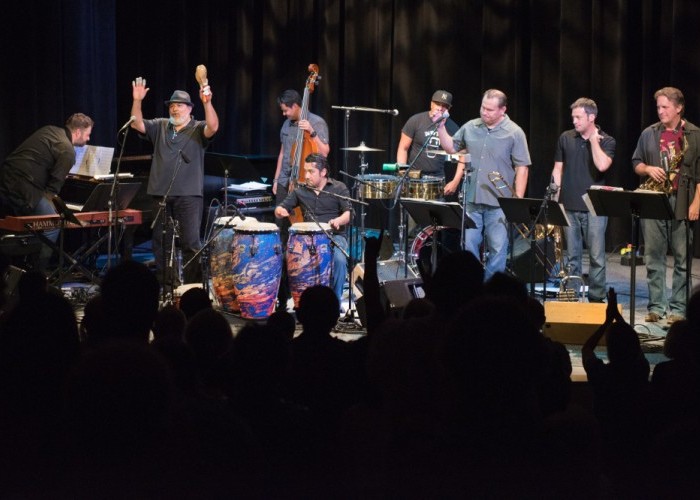Oct 28, 2025 10:47 AM
In Memoriam: Jack DeJohnette, 1942–2025
Jack DeJohnette, a bold and resourceful drummer and NEA Jazz Master who forged a unique vocabulary on the kit over his…

The crowd applauds a performance by legendary percussionist Poncho Sanchez (second from left) at MCG Jazz in Pittsburgh.
(Photo: Courtesy MCG Jazz)In 1983, when Marty Ashby was a struggling young jazz guitarist in New York City, fresh out of Ithaca College, he went looking for a day job. Answering a classified ad from the New York Philharmonic, he found himself in an elevator with a man carrying a stack of sheet music.
“I asked him,” Ashby recalled, “what his gig was, and he said, ‘I put the scores on the music stands.’ I said, ‘That’s a gig?” And I realized that the four floors of this building were full of people like him, who supported some of the finest musicians in the world. But I was a jazz musician, and I was used to playing with some of the finest musicians in the world in front of the New York Public Library for tips. That’s when I realized that jazz didn’t have the same support system as classical music.”
That epiphany led Ashby to found MCG Jazz in 1987 to provide just such support. It was part of the Manchester Craftsmen’s Guild, a non-profit organization that provides arts education to local children. Founded by Bill Strickland, the group built its headquarters near the economically depressed Manchester neighborhood in north Pittsburgh and equipped the facility with a 350-seat concert hall and recording studio.
Drawing on his experience with the New York Philharmonic, Ashby launched one of the earliest jazz subscription series for a 1987–’88 concert season that included Betty Carter, Kenny Burrell and James Moody. The series quickly became so renowned that from 1992 through 1995 NPR broadcast “Jazz at Manchester Craftsmen’s Guild.” Listening to those tapes, Ashby realized that MCG Jazz could release its own recordings.
“We were already paying the musicians to come play, so the extra upcharge for recording them was a lot less than taking them into the studio,” Ashby said. “One of our first recordings was the Count Basie Band with the New York Voices, and lo and behold it won a Grammy.”
The label’s latest release, Meeting Of Minds, also features the New York Voices, this time with the Bob Mintzer Big Band. With four singers and a large ensemble (including Ashby on guitar), such a project is an expensive undertaking. But just like San Francisco’s SFJAZZ, MCG Jazz offers institutional support that keeps big band jazz alive.
“For a composer/arranger, a big band is fantastic because you have so many colors and possibilities to work with,” said Mintzer, saxophonist for the Yellowjackets and the chief conductor for Germany’s WDR Big Band. “There’s something very compelling about an 18-piece jazz group playing as one. ... If big bands went away, a lot would be missing: less playing opportunities for musicians and poorer listening experiences for audiences. But I don’t see them going away, thanks to organizations like MCG Jazz.”
In addition to concerts—René Marie and Delfeayo Marsalis (Feb. 23) and Kurt Elling (Oct. 6)—and upcoming releases by pianist Frank Cunimondo and the DIVA Jazz Orchestra, MCG Jazz also has made education part of its mission, providing master classes, internships and other educational opportunities for the youth of Pittsburgh. DB

Jack DeJohnette boasted a musical resume that was as long as it was fearsome.
Oct 28, 2025 10:47 AM
Jack DeJohnette, a bold and resourceful drummer and NEA Jazz Master who forged a unique vocabulary on the kit over his…

D’Angelo achieved commercial and critical success experimenting with a fusion of jazz, funk, soul, R&B and hip-hop.
Oct 14, 2025 1:47 PM
D’Angelo, a Grammy-winning R&B and neo-soul singer, guitarist and pianist who exerted a profound influence on 21st…

Kandace Springs channeled Shirley Horn’s deliberate phrasing and sublime self-accompaniment during her set at this year’s Pittsburgh International Jazz Festival.
Sep 30, 2025 12:28 PM
Janis Burley, the Pittsburgh International Jazz Festival’s founder and artistic director, did not, as might be…

Jim McNeely’s singular body of work had a profound and lasting influence on many of today’s top jazz composers in the U.S. and in Europe.
Oct 7, 2025 3:40 PM
Pianist Jim McNeely, one of the most distinguished large ensemble jazz composers of his generation, died Sept. 26 at…

Drummond was cherished by generations of mainstream jazz listeners and bandleaders for his authoritative tonal presence, a defining quality of his style most apparent when he played his instrument unamplified.
Nov 4, 2025 11:39 AM
Ray Drummond, a first-call bassist who appeared on hundreds of albums as a sideman for some of the top names in jazz…